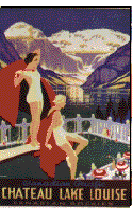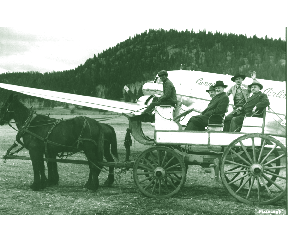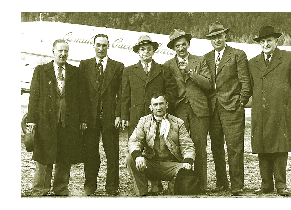
|
|
Airport
Links .
Rates
and Parking .
Tourism
. Commerce Williams
Lake: Gateway to Cariboo Country and the Wagon
Trail to BC's Gold
fields An 1863 traveler
described the 150 Mile Roadhouse as "A large,
square unfinished house, billiard room, lots of
geese, ducks and chickens and all kinds of
vegetables". The village around the house included
a district telegraph office, express office, post
office and provincial constable's office. Groups
would travel from roadhouse to roadhouse for
nightly dances usually lasting until
dawn.
Gold Rush
Trail.
When the
Wagon Road was extended from Lac La Hache to Soda
Creek, the initial intention was to route through
Williams Lake. However, when the road was at 140
Mile House , a falling-out over an attempt to
borrow temporary funds to meet the payroll resulted
in a rerouting through 150 Mile
House. When rails
replaced wagons for the transport of goods and
people, Williams Lake replaced 150 Mile House as a
center for goods and services. There are two
stories about the origin of "Williams Lake". One is
that it was named for Chief William, a Shuswap from
the Sugarcane area who did much to avert hostility
between Indians and white settlers. The other is
that it was named for William Pinchbeck, an early
settler who was well known for his pack train
service to the gold fields. Pinchbeck also built a
ranch, hotel, stopping house, brewery, and had
large fields, vegetable gardens and whiskey
still .I The village of
Williams Lake was incorporated in 1929. Throughout
the 1930's and 40's, Williams Lake continued to
grow as a cattle town. In the late 1940's and
1950's the forest industry began to develop in the
area. Between 1961 and 1981, the population grew
from 2,000 to 9,300 due to expansion of the forest
industry, the establishment of Gibraltar Mine and
the emergence of the city as an administrative
center for the Cariboo. The famous Williams Lake
Stampede was officially started in the 1920's. It
had its roots in horse racing and contests from the
early days on the Pinchbeck farm, and is now a
major professional rodeo. Steamboats were
operating from Soda Creek by October 1963, but men
were still running the river in other craft.
Steamers traveled the upper Fraser River from 1863
to 1921. During the Gold Rush, Soda Creek boated
one of the original telegraph offices, a sporting
house, floor mill and various shops. When travelers
left Soda Creek, they headed north along the Fraser
to Australian Ranch via Fort Alexandria, a Hudson's
Bay trading post named for Alexander Mackenzie. The
ranch was established by two miners who came to the
Cariboo from Australia during the Gold
Rush. The modern day
traveler is more likely to arrive in the Cariboo
Chilcotin region via air at Williams Lake Airport,
whose quality of service was rewarded in 1993 with
the Airport Excellence Award for Community
Relations. Or you can arrive at a slightly more
leisurely pace aboard BC Rail's Cariboo Dayliner
from North Vancouver, and take in the spectacular
scenery of Howe Sound and Whistler on the way. Or
if you're coming by car, follow the Gold Rush Trail
(Highway 97) - guaranteed to be less treacherous
than the route struggled over by the region's first
prospectors. Named
"Columneetza" , meaning "meeting place of princely
people" by the Athapascan natives who once lived in
this area, Williams Lake has now grown to be the
main administrative, commercial, and supply center
for the central Cariboo and Chilcotin regions.
Ranching, forestry, transportation and services are
the community's principle industries.
Truly cowboy
country, Williams Lake is famous for hosting one of
BC's largest stampedes and has a distinctly western
frontier character. Guest ranches abound so the
visitor can indulge all his wild west fantasies, or
if gentler pursuits are more to your taste, you can
bird watch at the Scout Island Nature Center or
take the Marguerite Ferry located 63 km north of
Williams Lake and imagine yourself back in time on
one of the old paddle wheelers floating upstream to
Quesnel. Williams Lake is
the gateway to the Big Lakes country. Take Highway
97 to 150 Mile House, where a good paved road, once
an early prospectors route, will take you to
Horsefly, the scene of the first Cariboo gold
discovery in 1859. The Horsefly River is famous for
its fly-fishing and hosts the second largest annual
sockeye salmon run in BC, at the end of August. 45
km further north is picturesque Quesnel Lake, set
against the backdrop of the Cariboo Mountains. One
of the province's largest lakes, it offers
exceptional fishing, yielding popular trout
species.
http://www.techcentre.bc.ca/connector/williamslake/qtran.htm |

 As
the 1850's Gold Rush progressed up the Fraser to
the Interior, trails were built, improved and
finally upgraded to roads. Independently owned
roadhouses sprang up every 30-40 km along the
Cariboo Wagon Road, providing food and shelter for
miners, travelers and pack animals. By 1863, the
road was completed to Soda Creek, and serviced by
the Barnard Express Stage Company. One of the many
stops along the way was 150 Mile House. The small
community became the departure point for mining
settlement that sprung up on the banks of Keithly,
Antler and Horsefly Creeks.
As
the 1850's Gold Rush progressed up the Fraser to
the Interior, trails were built, improved and
finally upgraded to roads. Independently owned
roadhouses sprang up every 30-40 km along the
Cariboo Wagon Road, providing food and shelter for
miners, travelers and pack animals. By 1863, the
road was completed to Soda Creek, and serviced by
the Barnard Express Stage Company. One of the many
stops along the way was 150 Mile House. The small
community became the departure point for mining
settlement that sprung up on the banks of Keithly,
Antler and Horsefly Creeks. n
1919, Williams Lake town site was surveyed into
blocks and lots, streets and avenues. In September,
the first train arrived. Later that year the
Pacific Great Eastern station was built and the
railway bridge crossed the creek. The station now
houses an art gallery.
n
1919, Williams Lake town site was surveyed into
blocks and lots, streets and avenues. In September,
the first train arrived. Later that year the
Pacific Great Eastern station was built and the
railway bridge crossed the creek. The station now
houses an art gallery.